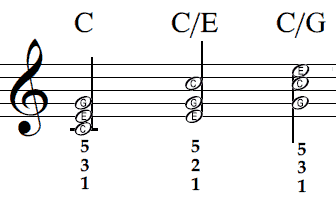Inversions of piano chords
When you learn how to play chords, you will have a tremendous benefit from understanding how to use inversions. An inverted chord is the same chord but played with the chord notes in a different order and the bass note replaced. This article introduce you to the concept with diagrams and tables supporting the explanations. See also the interactive Piano chord inversions finder for checking up on various chords with their inversions.
Chord inversions finder ›
The concept of inverted chords is straightforward: the tones are shifting places. Take the C Major chord as an example ... The standard way to play the chord is with the notes C, E, G:
Root position of C Major

But you can invert the chord and create two alternative versions of it:
1st inversion of C Major

The order of notes change to E, G, C and this chord is called C/E (C major with E at the bottom).
2nd inversion of C Major

The order of the notes changes to G, C, E and this chord is called C/G (C major with G at the bottom).

The picture illustrates the same chords and how they can be played in standard notation (G-clef). The numbers written below the note symbols indicate fingerings: thumb (1), index (2) middle (3) and little finger (5) for the right hand.
Inverted chords are abbreviated with a slash and the letter of the bass tone after the name of the chord (see the tables of inverted chords below). The chord in root position and the inversions will sound similar (they all maintain a C major harmony), but obviously not exactly the same. Play the chords at the piano and listen. One thing to notice is that the intervals change when the notes are rearranged.
Why use inverted chords?
By now you may think: “Why complicate things by using different versions of the same chord?” The answer is: by using inverted chords you can minimize the movement of your hand and as a result play faster. A second positive outcome of this is that you will be able to play more comfortably without looking at the keyboard – the reason is the same: the movements are minimized.
Voice leading
The third important reason behind inversions falls under the subject of voice leading. Voice leading is about moving from chords and trying to find common tones, which demands the least amount of motion of the chord hand.
Instead of making large jumps with the hand, which is necessary if all chords are played in root position, involving inversions will add more choices and minimize movement, which often creates a more pleasant harmony as well as making it easier to play (especially without eye contact with the hands and keyboard).
One way is to use inversions is to shape bass lines (bass lines are the sequence of the lowest notes) in the chord changes. By using inverted chords, it is possible to a higher degree decide which the lowest note in the chord should be. A progression such as C - G - Am - F - E - C can be arrange as C - G/B - Am - F/A - E/B - C, which in many situations will sound better.
Triads – two inversions are possible
For triads (i.e. chords with three notes) two inversions are possible. Here are two lists of all major and minor chords with inversions.
| 1st inversion | 2nd inversion | |
|---|---|---|
| C | C/E | C/G |
| C# | C#/F | C#/G# |
| D | D/F# | D/A |
| D# | D/G | D/A# |
| E | E/G# | E/B |
| F | F/C | F/A |
| F# | F#/A# | F#/C# |
| G | G/B | G/D |
| G# | G#/C | G#/D# |
| A | A/C# | A/E |
| A# | A#/D | A#/F |
| B | B/D# | B/F# |
| 1st inversion | 2nd inversion | |
|---|---|---|
| Cm | Cm/Eb | Cm/G |
| C#m | C#m/E | C#m/G# |
| Dm | Dm/F | Dm/A |
| D#m | Dm/F# | Dm/A# |
| Em | Em/G | Em/B |
| Fm | Fm/B | Fm/A |
| F#m | F#m/A | F#m/C# |
| Gm | Gm/A# | Gm/D |
| G#m | G#m/B | G#m/D# |
| Am | Am/C | Am/E |
| A#m | A#m/C# | A#m/F |
| Bm | Bm/D | Bm/F# |
Four-note chords – three inversions are possible
For a four-note chord, three inversions are possible. Below is a list of dominant seventh chords with inversions.
| 1st inversion | 2nd inversion | 3rd inversion | |
|---|---|---|---|
| C7 | C7/E | C7/G | C7/Bb |
| C#7 | C#7/F | C#7/G# | C#7/B |
| D7 | D7/F# | D7/A | D7/C |
| D#7 | D7/G | D7/A# | D7/C# |
| E7 | E7/G# | E7/B | E7/D |
| F7 | F7/C | F7/A | F7/Eb |
| F#7 | F#7/A# | F#7/C# | F#7/E |
| G7 | G7/B | G7/D | G7/F |
| G#7 | G#7/C | G#7/D# | G#7/A# |
| A7 | A7/C# | A7/E | A7/G |
| A#7 | A#7/D | A#7/F | A#7/G# |
| B7 | B7/D# | B7/F# | B7/A |
You can find pictures of all these chords on this site. You could also download the free ebook Piano Chords Practice, which include chord exercises with inversions.
In some musical notations, inversions are written with subscript letter after the chord note. Here are some examples:
C = Ca (when referring to the root position of C major)
C/E = Cb
C/G = Cc
Cmaj7/B = Cmaj7d
See also Voicings ›